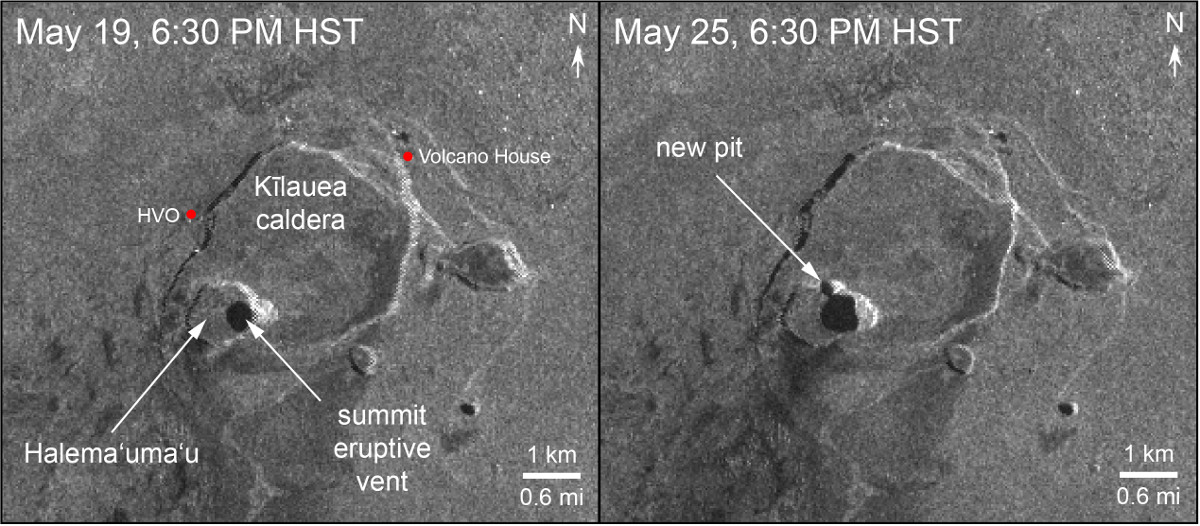
USGS: This image shows radar data acquired by the European Space Agency’s Sentinel-1 satellite over Kīlauea Volcano on May 19 at 6:30 PM HST (left) compared to May 25 at 6:30 PM HST (right). The satellite transmits a radar signal toward the surface and measures the strength of the return, with bright areas indicating a strong return and dark areas a weak return. Strong returns indicate rough surfaces or slopes that point back at the radar, while weak returns come from smooth surfaces or slopes angled away from the radar. Comparing the two images shows that the summit eruptive vent continues to expand as the unsupported conduit walls collapse
(BIVN) – As dramatic changes are occurring on the floor of Halema‘uma‘u crater, and as explosive events are expected to continue, scientists are learning more about the activity at the summit of Kīlauea Volcano.
On Monday, “ash continued to erupt intermittently” from the expanding vent within Halemaʻumaʻu crater, the USGS Hawaiian Volcano Observatory stated. “Winds have weakened and shifted in direction so that ash fall could occur in communities around the summit area.”
USGS also made this stunning comparison:
As of the afternoon of May 25, the vent expansion included not only continued westward growth of the vent rim, but also a subsidiary pit on the north part of the floor of Halema‘uma‘u crater. The vent area is now approximately 90 acres, and we anticipate further enlargements over the coming days to weeks as subsidence of Kīlauea caldera, rockfalls, and small explosions continue.
“The current Halemaʻumaʻu was formed by explosions in 1924,” said Jim Kauahikaua of the USGS HVO when asked about the vent expansion during a press conference on Monday. “Previous to the explosions Halemaʻumaʻu was half the diameter that it is today. We are seeing many aspects of 1924 over again, and one of them is the widening of the actual vent down to – whatever’s down there.”
“But we’re also learning a great deal about how these explosions occur,” Kauahikaua continued. “One of the interesting findings is that they may be more related to gas than steam as we once thought. Our senior geologist Don Swanson is looking at all that data and he is beginning to think that maybe the steam blast idea was not quite accurate.”
“That’s causing him to look back in 1924 – when they had far less instrumentation or analytical capabilities – and thinking that maybe 1924 wasn’t steam blast either,” Kauahikaua said. “That it was the same mechanism, more like gas pressurization and … expansion, explosion.”
The new theory is a work in progress. “There are some instrumental measurements that contradict that,” Kauahikaua said. “So in science, it goes on, we keep asking questions.”
A magnitude 4.1 earthquake occurred at 5:39 p.m. Monday on the Koa’e fault zone south of the caldera. Earthquakes in the summit region continue as the summit area subsides and adjusts to the withdrawal of magma, USGS says.

by Big Island Video News12:52 am
on at
STORY SUMMARY
HILO, Hawaii - Scientists are beginning to think that "maybe the steam blast idea was was not quite accurate," and recent summit explosions could be more related to gas.